An avatar and his Divine mission through the ages
“Sir, are you an avatar?” a young Swami Kriyananda once asked Paramhansa Yogananda.
With quiet simplicity, Yogananda replied, “A work of this importance would have to have been started by such a one.” (Swami Kriyananda, The New Path)
What is an avatar? What “work of importance” was Yogananda referring to? Is there more than one avatar and do they all have works of importance? Who assigns them these works? And, finally, has Yogananda come as an avatar in other lifetimes with other works of importance?
These fascinating questions arise naturally from Kriyananda’s short conversation with Yogananda.
In this article, we will embark on an excursion that will answer these questions in detail. The answers will give us a deeper understanding of Yogananda’s spiritual stature, the extraordinary roles he played over many incarnations as a divine instrument, and the transformative impact Yogananda’s most recent incarnation and mission are destined to have on the world and on you and me.
What is an avatar?
This question is a natural starting point for our journey.
In yogic parlance, an avatar is a soul who comes back to the material plane after having reached the pinnacle of spiritual evolution.
Kriyananda explained the soul’s journey toward Self-realization as follows:
When a soul, after many incarnations of spiritual striving, reaches the highest state of nirbikalpa samadhi, it irrevocably realizes its oneness with God. Such a soul is said to have attained Self-realization and is called a jivan mukta, Sanskrit for “freed while living.”
A jivan mukta has dissolved his ego; therefore he cannot create new karmic entanglements or slip back into delusion. However, the jivan mukta is not yet completely free: his past karma, accrued from ego-driven actions of previous incarnations, still needs to be worked out. Through reincarnation(s), the jivan mukta gradually works out all his past karma. When the jivan mukta has freed himself of all past karma as well, he becomes a param mukta (supremely free soul) or siddha (perfected soul).
Souls that reach this highest state of emancipation are freed from the cycle of forced reincarnation. Their natural state is to remain eternally immersed in the highest realm of ever-new bliss. If one such soul ever incarnates again, it never does so except at the command of the Divine Will. When such a supremely free soul returns to this world, it comes only for the sake of humanity. A soul with such an incarnation is called an avatar or divine incarnation.
Yogananda gives a similar, concise description of the stages of Self-realization in Autobiography of a Yogi:
The Sanskrit word avatara means descent; its roots are ava (down), and tri (to pass). In the Hindu scriptures, avatara signifies the descent of Divinity into flesh.
The Upanishads have minutely classified every stage of spiritual advancement. A siddha (perfected being) has progressed from the state of a jivan mukta (freed while living) to that of a paramukta (supremely free—full power over death); the latter has completely escaped from the mayic thralldom and its reincarnational round. The paramukta therefore seldom returns to a physical body; if he does, he is an avatar, a divinely appointed medium of supernal blessings on the world. (Ch. 33, “Babaji, Yogi-Christ of Modern India”)
Is there more than one avatar?
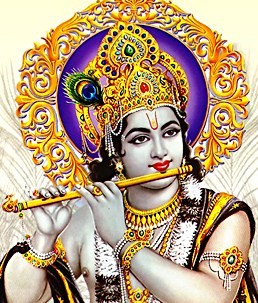
Lord Krishna
The answer is yes. Yogananda said that among others, Rama, Krishna, and Buddha were avatars. He also stated that all the masters of this ray of Self-realization—Jesus Christ, Babaji, Lahiri Mahasaya, Swami Sri Yukteswar, and Yogananda himself—were avatars as well. There are probably others he did not mention.
Do avatars always come with a mission of world importance?
The answer, again, is yes.
Yogananda explained that when jivan muktas reincarnate, they do so to work out their own past karma and progress toward full emancipation (the state of param mukta or siddha). Additionally, they guide their own disciples on the journey toward Self-realization. Primarily, jivan muktas are given the responsibility to help their own disciples.
The avatars, having already won their own complete freedom, incarnate with the full power of divinity. They come not only to help their own direct disciples toward soul-freedom but also to fulfill divine missions that are designed to uplift entire civilizations.
The Bhagavad Gita, a Hindu scripture that is essentially a conversation between Krishna (who represents God, the Supreme Spirit) and Arjuna (who represents the ardent and sincere seeker), states this cosmic principle in one of its most well-known shlokas (verses):
Though I (a fully liberated soul) am the Lord of all creation, yet I, by My yoga-maya, assume (from time to time) an outward form.
O Arjuna! whenever virtue (dharma) declines, and vice (adharma) is in the ascendant, I incarnate Myself on earth (as an avatar). Appearing from age to age in visible form, I come to destroy evil and to re-establish virtue. (Bhagavad Gita, IV:6-9)
Has Paramhansa Yogananda come before as an avatar?
Indeed, yes!
In his poem “God’s Boatman” Paramhansa Yogananda promises to come as often as needed in order to bring salvation to truth-seekers:
I want to ply my boat, many times,
Across the gulf after death,
And return to earth’s shores
From my home in space.Oh! I will come back again and again!
Crossing a million crags of suffering,
With bleeding feet, I will come,
If need be, a trillion times,
As long as I know that
One stray brother is left behind.(Read the full poem here.)
In addition to his promise to future generations of seekers, Yogananda told his disciples that he had incarnated numerous times in the near and the distant past to serve as an instrument of the Divine.
What follows is a summary of some of Yogananda’s past incarnations, some mentioned by Yogananda himself. Others were suggested by Kriyananda based on his own intuition and conversations with Yogananda. These provide deep insight into the many roles Yogananda has played over the millennia. Each of these incarnations, as befits an avatar, has had a deep and lasting influence on the course of human history.
Yogananda as Arjuna
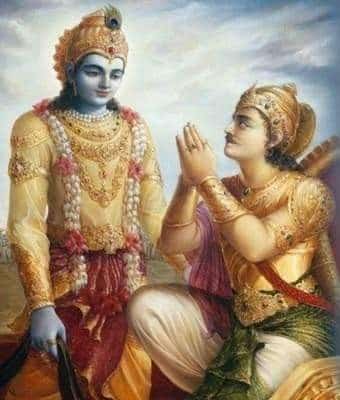
Arjuna and Lord Krishna
Yogananda told his disciples that he had been Arjuna (circa 700 BCE), ancient India’s foremost warrior, and Babaji had been India’s foremost prophet, Krishna. Yogananda was already a fully liberated soul in that lifetime. The Sanskrit word Arjuna literally translates as one who has untied the cord (of delusion).
Although the actual lives of Arjuna and Krishna are shrouded in mystery, their roles as principal heroic characters of the Mahabharata and the Bhagavad Gita have been a transformative influence on the evolution of spirituality in India. Yogananda said that one reason he was tasked with writing the commentaries on the Bhagavad Gita was that he had been Arjuna in that lifetime.
Yogananda as William the Conqueror
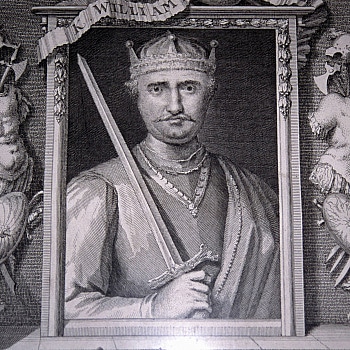 Yogananda also often told his disciples that he had been William the Conqueror (circa 1028–1087 AD), King of Normandy and England. Swami Sri Yukteswar, Yogananda’s guru, had been Lanfranc, William’s closest friend and counselor and the Archbishop of Canterbury.
Yogananda also often told his disciples that he had been William the Conqueror (circa 1028–1087 AD), King of Normandy and England. Swami Sri Yukteswar, Yogananda’s guru, had been Lanfranc, William’s closest friend and counselor and the Archbishop of Canterbury.
William united the constantly warring earldoms into one kingdom and gave England much of its present-day character. He also guided England away from the wanton influence of the Danes and into that of Roman Catholic Christianity. England, as a foremost colonial power, later played a central and far-reaching role in shaping the course and the affairs of the modern world.
William’s historical reputation is mixed. He is regarded highly in Norman society and history but British historians often view him in an unfavorable light. The historian David Douglas writes:
Various controversies have led to William being seen by some historians either as one of the creators of England’s greatness or as inflicting one of the greatest defeats in English history. Others have viewed him as an enemy of the English constitution, or alternatively as its creator.
The written records of medieval times can be conflicting and highly unreliable. When someone mentioned a particularly unflattering incident from William’s historical life, Yogananda remarked, “How they distort history. That incident never happened. William was a great man.” According to Norman historical records, William’s body was incorrupt when it was exhumed nearly 400 years after his passing.
Yogananda sometimes told his disciples who they had been during William’s lifetime. Somehow, it did not occur to Kriyananda to ask what role he had played. He later felt that Yogananda had prevented that question from arising in his mind. A few years after Yogananda’s passing, Kriyananda had a deep intuition that he had been King Henry I, William’s true heir and successor. As King Henry, Kriyananda helped complete the mission that William had begun.
Two Souls, Four Lives by Catherine Kairavi, a long-time resident of Ananda Village, is a fascinating and well-researched book about Yogananda’s incarnation as William and Kriyananda’s incarnation as Henry. It is well worth reading.
Yogananda as Jesus Christ?
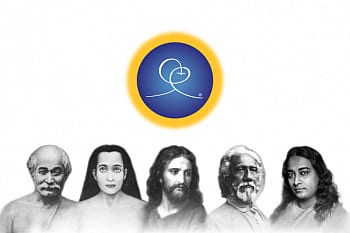
Masters of Self-Realization: Yogavatar Lahiri Mahashaya, Mahavatar Babaji Krishna, Jesus Christ, Gyanavatar Swami Sri Yukteswar, & Paramhansa Yogananda.
Yogananda never stated directly that he had been Jesus in a previous life. However, he did state that Babaji, Lahiri Mahasaya, and Swami Sri Yukteswar had been the three wise men who visited the baby Jesus.
When Kriyananda heard this, he wondered, “Well! Who, then, had Yogananda been?” Additionally, Yogananda called his present mission The Second Coming of Christ and wrote profound commentaries on Jesus’ teachings from the New Testament as part of that mission. Kriyananda also felt the same vibration in Jesus’ words, deeds, and teachings as he felt in attuning to Yogananda’s consciousness.
Kriyananda, with so many clues swirling around, finally asked his guru the point-blank question… (Thank you, Swamiji, for asking all these questions!), “Sir, were you Jesus Christ?”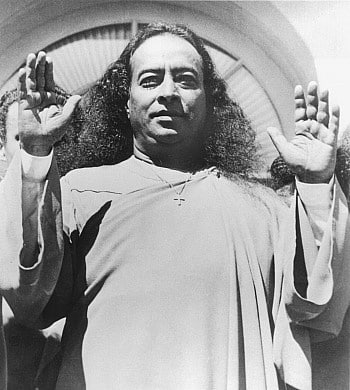
Yogananda would only give an indirect answer to Kriyananda’s question:
What difference does it make? It’s the same ocean that produces all the waves.
One suspects that such a public revelation would have caused more commotion (a tsunami!) than benefit.
As the years passed by, Kriyananda felt more and more strongly that Yogananda had indeed been Jesus. In this article, we will leave it at that. You can make up your own mind! By the way, in an ongoing course about the Bible commentaries of Yogananda, we explore many of the yogic truths hidden in the teachings of Jesus.
Yogananda as Adi Shankara?
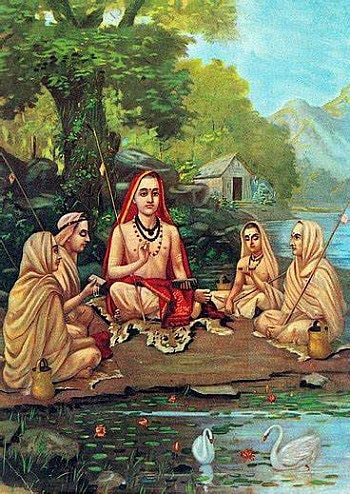 Adi Shankara (circa 510–478 BCE or circa 800 CE according to scholars) was India’s foremost proponent of the Vedanta philosophy and founder of the ancient Swami Order. He revived Hinduism at a time when it was in decline and had nearly been supplanted as India’s principal religion. Although Shankara lived only 32 years, his influence on the evolution and expression of spirituality in India has largely been unmatched. The effect of the spiritual renaissance he started in India can be felt to this day.
Adi Shankara (circa 510–478 BCE or circa 800 CE according to scholars) was India’s foremost proponent of the Vedanta philosophy and founder of the ancient Swami Order. He revived Hinduism at a time when it was in decline and had nearly been supplanted as India’s principal religion. Although Shankara lived only 32 years, his influence on the evolution and expression of spirituality in India has largely been unmatched. The effect of the spiritual renaissance he started in India can be felt to this day.
Yogananda once again did not state directly that he had been Shankara. Kriyananda, however, felt that this had been so. Kriyananda noted among other things, the many stories that Yogananda told of Shankara’s life that exist nowhere else in literature. Yogananda could only have known them if he had himself been Shankara.
Here is one such fascinating story that Yogananda narrated (from Kriyananda’s book Conversations with Yogananda):
Babaji, many centuries ago, lived in a house in Benares. He had a servant. When Swami Shankara came to that city, his renown preceded him as an astrologer. Babaji’s servant went to him for a reading. When he returned, he was trembling.
“What’s the matter?” Babaji asked him.
“Swami Shankara says I will die tonight!”
“Go back to him,” said Babaji, “and tell him that it won’t happen.”
The servant returned to Shankara with Babaji’s message. That saint replied, “This karma is so strong that, if your master can prevent its coming to fruition, I will go to him and become his disciple!”
That night, Babaji extended himself on the body of the quaking man. A huge storm suddenly swept over the area. Whole trees were uplifted. Lightning struck repeatedly all around the house. When morning came, however, the man was still alive. He went back to Swami Shankara who, on seeing him, hurried back with him and prostrated himself before Babaji. It was then that he asked for initiation, and Babaji taught him Kriya Yoga.
Babaji as Shankara’s guru and Shankara’s practicing Kriya Yoga are also bonds that lend weight to Kriyananda’s intuition that Yogananda had been Shankara in a previous lifetime.
Yogananda as King Ferdinand III of Castile?
Let’s begin this section with another fascinating excerpt from Conversations with Yogananda:
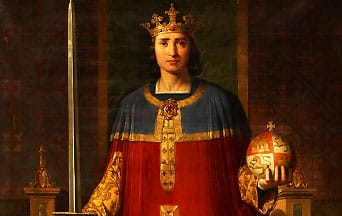
King Saint Ferdinand, III
One night, those living near the Master’s apartment at Mount Washington heard a loud sound of clanking metal. The following morning they learned the cause of that tumult.
At this point, I must back up a space. The Master had told some of his disciples that he had lived, centuries ago, as a military commander in Spain. His divinely appointed task at that time had been to help liberate that country from the Moors, in order to protect the integrity of Christianity. The noise that previous night had been caused by a Spanish soldier who had been under his command at that time. He had materialized in full armor to ask for the Master’s blessing that he be released – in what way, I have no idea. From what I understand, the Master gave him the release he sought.
In the present lifetime, the Master knew no Spanish. I remember him greeting me once, however, with a big smile, in Spanish. Señor Cuaron was visiting Mount Washington from Mexico City. What the Master said was, “Cuál es su nombre?” (What is your name?) I answered in Spanish, upon which the three of us had a good laugh.
Yogananda never told his disciples exactly which military commander he had been in that life. Ananda members, however, researched extensively and suggested to Kriyananda that Yogananda must have been Ferdinand, III – King of Castile (circa 11/29/1201–1252 AD).
Ferdinand was undefeated in battle. His outward mission, bravery, judicious rule, and deeply spiritual nature — all come together to make him a worthy choice. He was also deeply devoted to the Virgin Mary. He spent the nights before battle in deep prayer and rode into every battle with a small statue of the Divine Mother in his saddle. That statue still survives and is known as the Virgin of the Battles.
Ferdinand is revered as a Catholic saint. The Spanish call him Fernando, el Santo. His body remains incorrupt to this day.
In his later years, Kriyananda was able to meditate privately next to Ferdinand’s incorrupt body in Seville. He came away with a strong feeling that Yogananda had indeed been Ferdinand. Kriyananda also felt that he had been Ferdinand’s son and heir, King Alfonso X, called el Sabio (the Wise) by the Spanish. Alfonso’s mission had been, once again, to complete the mission that Ferdinand had started.
Ferdinand’s life had a dramatic impact on the evolution of Spain as a nation. Spain later, as a mighty colonial power, had a far-reaching influence on the evolution of the present-day world, including many nations, their languages, and their customs.
Yogananda’s next incarnation
One can only wrap up this fascinating roster of Yogananda’s past incarnations by pondering the obvious question, “When will Yogananda be born again?”
Kriyananda notes in The New Path that Yogananda addressed this question partially:
His next life on earth, Master told us, would be spent in the Himalayas. Having devoted so much of his present life to public service, he planned to remain for many years of that incarnation in deep seclusion. ‘In my later years,’ he told us, ‘I will gather about me those who are close to me now.’
Two hundred years would elapse, he told us, before his next incarnation.
How the Divine uses an avatar
A study of Yogananda’s many past incarnations gives us deep insight into how the Divine Will uses an avatar.
All devotees probably feel at one point or another (justifiably so) that God remains far too aloof from his Creation. After all, God created this world. Surely, it behooves Him to take more of a direct interest in this world and to influence it for the better!
Kriyananda said that God does indeed take a real and active interest— through the agency of the avatars. Again and again, these fully liberated souls come and play a divine part in guiding the world’s evolution in the right direction.
A couple of valid questions arise: Can’t the avatars do more? Shouldn’t they do more?
Kriyananda explained that it is not God’s way to impose His will through a diktat or through an overwhelming show of divine power. The avatars work to reshape and guide the world in accordance with the laws of individual karma that govern the progress of each soul and the laws of mass karma that govern the evolution of a planet. In other words, they seek to influence rather than impose.
Consider how a guru works with his disciples. A true guru does not impose or force Self-realization on his disciples. He rather allows them to take detours and to experience the consequences of their choices. A disciple’s Self-realization is a gradual process that takes incarnations.
The same principles also inform an avatar’s mission of guiding world evolution. It is a gradual process. The full extent of an avatar’s beneficial influence becomes evident only over millennia.
Paramhansa Yogananda – an avatar for the present age
 Yogananda came with a multi-faceted mission in this lifetime. Kriyananda talks about this in detail in his book Paramhansa Yogananda: A Biography. For brevity’s sake, here is a shortlist of some of those facets:
Yogananda came with a multi-faceted mission in this lifetime. Kriyananda talks about this in detail in his book Paramhansa Yogananda: A Biography. For brevity’s sake, here is a shortlist of some of those facets:
- He brought the technique of Kriya Yoga, the jet-plane route to Self-realization, as a part of a great lineage of masters.
- He interpreted key scriptures (the Bhagavad Gita, Bible, and Rubaiyat of Omar Khayyam) in a way that explains their highest principles and shows that these liberated souls spoke from their perception of the same One Truth. In particular, his commentaries on the Bible help sincere Christians tune into the true teachings of Jesus, free from Church dogma. His commentaries on the Bhagavad Gita bring out the truest teachings of Yoga, free from sectarianism, misunderstanding, and the forest of unnecessary ritual.
- He explained the deepest yogic teachings in a way that is understandable and in sync with the times we live in.
- His teachings make spirituality practical. They cover every aspect of life and show us how to spiritualize life’s various departments.
For these reasons, Kriyananda felt that Yogananda would come to be known as the avatar for the current age (Dwapara Yuga). Yogananda’s beneficial influence will be felt more and more strongly as this Age of Energy progresses. It will gradually guide humanity in a direction that is in ever-greater harmony with eternal spiritual principles.
Paramhansa Yogananda — God’s Boatman for you and for me

In addition to guiding a world mission, an avatar brings extraordinary grace for his disciples. Yogananda once told Kriyananda:
When traveling on the ocean, one comes upon areas, here or there, where the sea is calm. Even so, on the great ocean of delusion one finds, occasionally, areas of exceptional calmness. This happens when an avatar, or divine incarnation, is sent to earth with a special dispensation. All who come to him and tune in to his spirit find it relatively easy to escape delusion’s power. –The Essence of Self-Realization
When Yogananda was a little baby, as shared in Autobiography of a Yogi, Lahiri Mahasaya blessed him and told his mother:
Thy son will be a yogi. As a spiritual engine, he will carry many souls to God’s kingdom.
When Yogananda was about to leave for America, Swami Sri Yukteswar blessed him:
All those who come to you with faith, seeking God, will be helped. As you look at them, the spiritual current emanating from your eyes will enter into their brains and change their material habits, making them more God-conscious.
Yogananda himself said:
Those who join us on this path of Self-realization are not connected to some printing press but to a line of God-realized masters. God Himself, through them, overshadows this work. All who follow it sincerely, with devotion, will be brought to Him.
The coming of Paramhansa Yogananda thus represents an extraordinary spiritual opportunity for seekers like you and me. Truly, as Yogananda wrote in the chapter about Babaji:
“An avatar is a divinely appointed medium of supernal blessings on the world.”
Friends, let us hop into the boat with this exceptional Boatman of God so that he may bear us away swiftly to the Divine Shores!
-Brahmachari Sagar
FURTHER READING
You might also be interested in the following resources that inspired this article:
Paramhansa Yogananda – A Biography, Swami Kriyananda, Chapter 15, “Reincarnation” and Chapter 27, “Magnetism.”
The New Path, Swami Kriyananda, Chapter 37, “The Guru’s Reminiscences.”

32 Comments
What a fascinating and inspiring read! Thank-you so much for sharing.
Thank you for the wonderful and amazing explanation of how the cosmic journey to self realization actually manifests.
Thank you Sagar, this is a good article!
Thank you, Sagar, for such a succinct and knowledgeable explanation.
Thanks, Sagar!
Thank you Sagar for bringing these truths to life in your article. Yoganandaji is my precious Divine Guide. I am so grateful that i found him. 🙏🏽🙏🏽
Bahut achha!
This was a superb article, quite fascinating. Thank you Sagar. However, I feel Adi Shankaracharya’s timeline mentioned here (circa 510–478 BCE) needs to be checked again, as that timeline puts him just around 200 hundred years after Krishna, and around the same time as Buddha. Just a thought. But everything else was very interesting reading! :)
Hi Kailash,
The dates are indeed uncertain, but I used one of what’s in the footnote of the Autobiography of a Yogi, Ch. I become a Monk of the Swami Order
https://www.ananda.org/autobiography/#c24-f3
There Yogananda (or his editor, as not all footnotes were written by Yogananda in even the first edition) writes:
Shankara’s date is a center of the usual scholastic dispute. A few records indicate that the peerless monist lived from 510 to 478 B.C.; Western historians assign him to the late eighth century A.D.
See also: https://en.wikipedia.org/wiki/Adi_Shankara#Dating
Thanks a lot for sharing Sagar, was unaware of this :D
That was indeed eye opening. I have wondered why my path has been thus,a vision of Christ with a 3 colored band around His waist,now,since 1991 I have been studying Yoganands teachings. Thank you again for giving these teachings!
INTRESTING EXPLAINATIONS
supreme knowledge— about avataars– i am blessed— i some times feel … i know yogananda very closely– intutive feeling– i read ..auto biography of a yogi 5 yrs back,,,and
my life changed dramatically- i have read most of his books– after that and now at the age of 60 –i feel divine has showered his blessing on me– eternally grateful– my interest in material desires is getting diminished daily— slowly— my only concern now is the cruelity to animals which humans are subjecting it to— hope fully that also should end– with the coming of a NEW AVATTAR–for protection of animals– would like to play some part in this— how and when only the divine can decide– always pray that some role i should get— the creuelity to wds animals in this planet is something which send me to deep depression…
regards
ramesh
So interesting, many thanks
Thanks Sagar. Enjoyed reading this very well-researched and presented article.
Very thorough gathering of Divine messages captured in one offering….you are a master at this! Thank you, Sagar!🙏
I have read different books mentioned in the article at different times. Each one made its profound impact in understanding the teachings of Paramhansa Yogananada. But this articles gives a very comprehensive understanding of different incarnations of PY. It gives an understanding of an Avatar. Each one so mesmerising..I feel i have to read this article many more times to get full import.. Thankyou Sagar for writing such knowledgeable articles. Please continue to shower us with such wisdom…
My mind is absolutely blown… thank you so much Sagar 🙏💜 waow I will digest this for some time 😂
Amazing. Thank You Sagar ji for so profound and insightful Article.
Like so many others, I am grateful for all the information you share, Sagar, not just this article but also the explanations to questions that you give.. I am also grateful for your strong guidance in the meditation course.
Nice post as always, at the end of the day of service it has a most wonderful grounding back to peace, (the divine comforter), Blessings Great Souls, Jai Guru.
Dear Sagar, thank you very much for this wonderful spiritual and historical travel. Many things are so fascinating and many of them are yet in our heart in some way. This article deserves to be read many times. Thank you and many blessings
Thank you,Sagar ji,for this enlightening knowledge of Master’s journey to be here with us. We are indeed so blessed to follow this path.
Aum Guru🙏
Thanks Sagar
Nicely prepared and presented.
Very fascinating article. Thank you for writing it. I am grateful that the world has this line of enlightened Masters. We sure do need them
Thank you, Sagar. The combination of the entertaining description of Yogananda’s past lives plus the unique opportunity of his present incarnation for all is a powerful reminder and fills me with hope for spiritual freedom.
Thank you Sagar …This article about Master in various Avatars is so inspiring..So reassuring to read Masters poem God’s Boatman….where he promises to take back with Him even one devotee left behind …Wow !!
So much of information in this article Sagar …Thanks once again ..! Truely Blessed..Aum Aum AUM !
Thank you Sagar, totally inspiring lecture.
truly inspiring……………..I miss no longer being in Sacramento and so close to Ananda and also in Nevada City. I look forward to the wisdom all of the teachers share with me.
Reincarnation seems to be NEW to the western world but thanks to the teachings of Yogananda, all is well with me.
Thanks a lot sagar 🙏
Who was prophet Muhammed? Any idea?
Hi Santhosh, good question! Yogananda never commented on that!